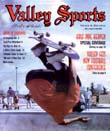|
|
THE BIKE BEAT:
Basic Tools for Bikin' Fools
Fall 2004, Valley Sports News & Review
 Do As I Say, Not As I Do:
September is National Preparedness Month, so naturally I thought
I'd do a column on being prepared. Of course, in true Bike Guy
fashion, I myself wasn't prepared, and therefore most of you won't
be reading this until October. There's a lesson in there somewhere...
Do As I Say, Not As I Do:
September is National Preparedness Month, so naturally I thought
I'd do a column on being prepared. Of course, in true Bike Guy
fashion, I myself wasn't prepared, and therefore most of you won't
be reading this until October. There's a lesson in there somewhere...
But, as our romping stomping editor Ed "The Ed" Cox says, being prepared is always a good idea, so over the coming winter months, we'll be looking at how cyclists can be better prepared. This time around, we'll be looking at what the average biker needs to keep their bike running in tip-top shape (and don't worry - in future columns, I'll explain how to use all this stuff).
BASIC TOOLS
One of the great joys of bicycles is their mechanical simplicity. I'm not saying you should be able to true a wheel blindfolded or rebuild your derailleur with one arm tied behind your back (bike shops exist for a reason, after all) but anyone over the age of twelve or so should be able to make minor adjustments to their bikes and at least understand how to change a flat. And parents take note: if you're not sure how to properly maintain a bike, this is the perfect time to do so. Learning something along with your childrenis one of those life moments you'll both treasure for a long, long time. I promise! Plus, you'll end up saving money in the long run, because a properly maintained bicycle will last just about forever. In fact, last I heard, my mother's 1930's Raleigh is still out there on the road somewhere, rolling merrily along.
Of course, to keep your bicycle properly maintained, you'll need a few basic tools. Fortunately it ain't rocket science -- you probably already have many of these items and the others are relatively inexpensive.
But first, a few words about tools. Quality is cheaper in the long run, so buy the best quality tools you can and avoid the bargain bin. A good tool, properly used and maintained, will last forever; a "good deal' may not. And always use the right tool for the job - trying to force a wrong-sized or poorly-manufactured wrench or screwdriver to fit the job at hand is almost always asking for stripped nuts and screws and skinned knuckles. Ouch!
Metric wrenches Like it or not, most bicycles are metric. Recommended sizes are 8, 9, 10, 11, 13, 14, 15 and 16 mm. Even better, you can usually find these sizes paired up as double-ended wrenches.
A small adjustable wrench: A nice set of metric bike wrenches and a matching ratchet set with all the appropriate sockets sizes is best, but a good quality adjustable wrench, also called a crescent wrench, will do in a pinch, and can be adjusted for those oddball sizes.
Screwdrivers: A 3/16" straight blade screwdriver and a #2 Phillips are perfect for adjusting derailleur limit screws, tightening brake lever bolts, replacing handlebar end plugs and a myriad of other tasks.
Pliers: 6" needle nose pliers ought to do just fine for pulling cables taut or snipping them to the correct length.
A multi-tool: The Swiss Army knives of bicycle repair, these little wonders are generally small enough to carry on the road with you, but I often find myself relying on them at home as well. There are as many types of these as there are bicyclists, ranging in price from under ten dollars up to well over fifty simolies. The good basic ones contain an assortment of the most commonly used hex-head wrenches (also known as Allen keys), screwdrivers and the like needed for normal bike maintenance. The more expensive ones may also include wrenches, detachable tire levers, chain tools and even a compass, although I'm not convinced a lot of these extra tools aren't more gimmicky than practical.
A chain tool or chain washer: A simple chain tool will let you push out a link pin on your chain so you can remove it for cleaning, but it can be a little tricky. A chain washer is a much easier solution. It allows you to clean your chain while it's still on the bike. Remember, the Antelope Valley is High Desert country, and desert means sand, so keeping your chain clean and well lubricated is essential. Nothing wears out your gears , derailleurs and chain faster than sand which is, after all, what they make sandpaper from.
A good lubricant or two: Forget the WD-40 or the Three-in-1 - those oils end up acting like sand magnets. A synthetic lubricant like Finish Line's "Dry-Style" Teflon-Plus bike lubricant is a good all-purpose choice for chains, cables and derailleurs. Synthetics tend to lubricate better, and actually repel dirt and grit. For internal parts such as hubs, headsets and the like a light grease is required. In all instances, I prefer using non-aerosol containers with drip applicators.
You'll also need a good degreaser for cleaning the drive-train before re-lubricating. There are several brands available, including many which are biodegradable. One reason I prefer biodegradable products is that they're generally easier on the hands and much easier to clean up after use.
A patch kit: Don't try to make do with that old inflatable pool repair kit your grandfather left you. Go out and splurge on a new bike tube repair kit, and replace it every year (the patches and that tiny tube of glue tend to dry out). It'll set you back three bucks or so, hardly a fortune, but it could save you the cost of a new tube and tire.
Tire levers: You'll need these to work a tire off the rim to repair or replace the tube. Forget those cheap metal levers - improperly handled, they can rip a tube to shreds in seconds. Instead, spring for some good plastic ones - three should do. And NEVER use a screwdriver!
A bicycle pump: An old-fashioned foot pump is still the best way to inflate bicycle tires. A built-in pressure gauge is a nice touch, but hardly a necessity. In fact, a separate gauge, and a small pump that conveniently clips on your bicycle itself will do. Make sure you get the type that fits your valves. Most bicycles have Schraeder valves, which look just like those on a car tire, but some fancy-pancy racing bikes use Presta valves, which require that a nut be loosened before the tire can be inflated.
A spoke key: For tightening loose spokes, or removing broken ones for replacement. Get the size that fits your bike.
A headset wrench: Again, get one that fits your bike. It's for adjusting your headset (the steering column at the front of your bike which connects the handlebars to the front wheel). A worthwhile investment - you do NOT want to strip your headset.
A third hand: No, not your buddy Leroy from next door, but a simple hand tool that holds your brakes closed when you're replacing or adjusting a cable.
A good bike stand: There are a zillion variations, including relatively inexpensive ones that fold out from the wall and expensive free-standing models, but they all do basically the same thing: they allow you to work on your bike while holding the rear wheel off the floor. Not positively absolutely essential, but it makes life so much easier, you'll wonder why it took you so long to get one. Definitely preferable to leaning your partially disassembled bike against the wall and hearing it crash to the floor when your back is turned.
And don't forget hand-cleaner, rags and
small containers to put all those little tiny parts in as you
take them off. Spreading some newspapers on the floor isn't going
to hurt anyone either.
Well, that's it for now. Next time, we'll look at what you'll
need as you head out on the road.
PENJACKING IN THE NEWS
Yep, I'm afraid it's true. Some Kryptonite bike locks can be picked with an ordinary Bic pen. For years Kryptonite U-locks, long the standard for bicycle security, have been thought unpickable and unbreakable. Alas, it turns out all it takes to pop open one of these formerly impregnable babies is a standard-issue ballpoint pen. Talk about corporate embarrassment!
Worse, there are even a couple of video clips and demonstrations making the rounds on the web showing just how easy it is to do. Evidently the pen is just the right size and just rigid enough to slip into the keyhole, but just malleable enough to form into the right shape and work as a key. But take a breath - not all Kryptonite locks are affected - only their Evolution and KryptoLok series are affected. But there's bad news for those outside the bike world -- the technique evidently works on other locks with similar tubular cylinder technology, like vending machines and even some automobile ignitions.
The good news is that the Canton, Ohio-based manufacturer, the world's largest bike lock company, has acted swiftly, and will be scrapping the vulnerable tubular cylinder lines, replacing them with ones using pen-proof disk-style cylinders. Meanwhile, all reputable bike shops are already pulling the troublesome models off their shelves.
Have any comments, suggestions, ideas? Lemme know. Operators are standing by. E-mail me at kvnsmith@thrillingdetective.com.

Kevin Burton Smith's first excursion without training wheels landed him in a ditch on the side of the road, but he swears, after almost four decades of cycling, that he's starting to get the hang of it. A transplanted Montrealer, he now lives in the Antelope Valley with local author D.L. Browne. Comments and suggestions for this column are welcome at bikeguy@thrillingdetective.com.
.